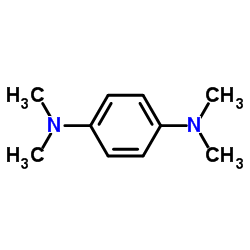Wurster's blue

Wurster's blue structure
|
Common Name | Wurster's blue | ||
|---|---|---|---|---|
| CAS Number | 100-22-1 | Molecular Weight | 164.25 | |
| Density | 1.0±0.1 g/cm3 | Boiling Point | 260.6±13.0 °C at 760 mmHg | |
| Molecular Formula | C10H16N2 | Melting Point | 49-51 °C(lit.) | |
| MSDS | USA | Flash Point | 104.9±7.7 °C | |
| Symbol |

GHS07 |
Signal Word | Warning | |
|
Cation binding site of cytochrome c oxidase: progress report.
Biochim. Biophys. Acta 1837(7) , 1188-95, (2014) Cytochrome c oxidase from bovine heart binds Ca(2+) reversibly at a specific Cation Binding Site located near the outer face of the mitochondrial membrane. Ca(2+) shifts the absorption spectrum of heme a, which allowed earlier the determination of the kinetic... |
|
|
Re-evaluation of the near infrared spectra of mitochondrial cytochrome c oxidase: Implications for non invasive in vivo monitoring of tissues.
Biochim. Biophys. Acta 1837(11) , 1882-91, (2014) We re-determined the near infrared (NIR) spectral signatures (650-980nm) of the different cytochrome c oxidase redox centres, in the process separating them into their component species. We confirm that the primary contributor to the oxidase NIR spectrum betw... |
|
|
Synthesis, characterization, evaluation and molecular dynamics studies of 5, 6-diphenyl-1,2,4-triazin-3(2H)-one derivatives bearing 5-substituted 1,3,4-oxadiazole as potential anti-inflammatory and analgesic agents.
Eur. J. Med. Chem. 101 , 81-95, (2015) A series of triazin-3(2H)-one derivatives bearing 1,3,4-oxadiazole (4a-4o) were synthesized, characterized and evaluated for anti-inflammatory and analgesic activities. Preliminary in vitro anti-inflammatory activity was assessed using an albumin denaturation... |
|
|
Analysis of polyunsaturated fatty acids and the omega-6 inflammatory pathway in hepatic ischemia/re-perfusion injury.
Mol. Med. Report. 12 , 4149-56, (2015) The aim of the present study was to assess omega-3 (n-3) and omega-6 (n-6) polyunsaturated fatty acids (PUFAs) in liver tissue and evaluate changes in the n‑6-associated inflammatory pathway following liver ischemia/re‑perfusion (IR) injury. Male Wistar rats ... |
|
|
Krill Oil Ameliorates Mitochondrial Dysfunctions in Rats Treated with High-Fat Diet.
Biomed Res. Int. 2015 , 645984, (2015) In recent years, several studies focused their attention on the role of dietary fats in the pathogenesis of hepatic steatosis. It has been demonstrated that a high-fat diet is able to induce hyperglycemia, hyperinsulinemia, obesity, and nonalcoholic fatty liv... |
|
|
Cytochrome bd from Escherichia coli catalyzes peroxynitrite decomposition.
Biochim. Biophys. Acta 1847(2) , 182-8, (2015) Cytochrome bd is a prokaryotic respiratory quinol oxidase phylogenetically unrelated to heme-copper oxidases, that was found to promote virulence in some bacterial pathogens. Cytochrome bd from Escherichia coli was previously reported to contribute not only t... |
|
|
The disruption of mitochondrial axonal transport is an early event in neuroinflammation.
J. Neuroinflammation 12 , 152, (2015) In brain inflammatory diseases, axonal damage is one of the most critical steps in the cascade that leads to permanent disability. Thus, identifying the initial events triggered by inflammation or oxidative stress that provoke axonal damage is critical for th... |
|
|
Neutrophils contribute to excess serum BAFF levels and promote CD4+ T cell and B cell responses in lupus-prone mice.
PLoS ONE 9(7) , e102284, (2014) Despite increased frequencies of neutrophils found in autoimmune diseases such as systemic lupus erythematosus (SLE), how they contribute to disease pathogenesis and the mechanisms that affect the accumulation of neutrophils are poorly understood. The aim of ... |
|
|
Mitochondrial dysfunction in some triple-negative breast cancer cell lines: role of mTOR pathway and therapeutic potential.
Breast Cancer Res. 16(5) , 434, (2015) Triple-negative breast cancer (TNBC) is a subtype of highly malignant breast cancer with poor prognosis. TNBC is not amenable to endocrine therapy and often exhibit resistance to current chemotherapeutic agents, therefore, further understanding of the biologi... |
|
|
Cytochrome c551 and the cytochrome c maturation pathway affect virulence gene expression in Bacillus cereus ATCC 14579.
J. Bacteriol. 197(3) , 626-35, (2015) Loss of the cytochrome c maturation system in Bacillus cereus results in increased transcription of the major enterotoxin genes nhe, hbl, and cytK and the virulence regulator plcR. Increased virulence factor production occurs at 37°C under aerobic conditions,... |